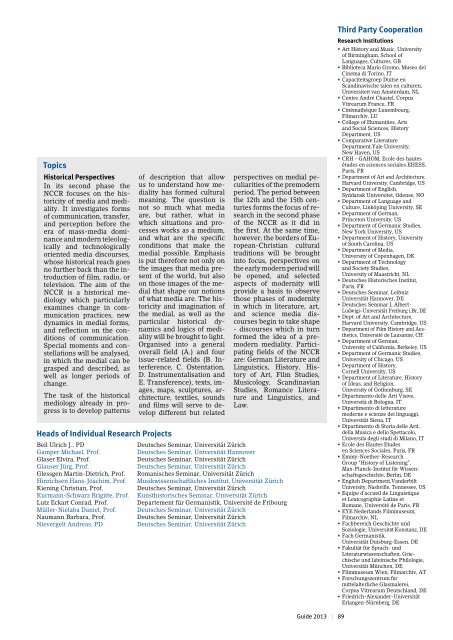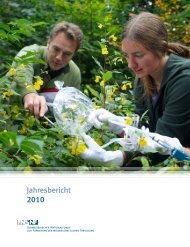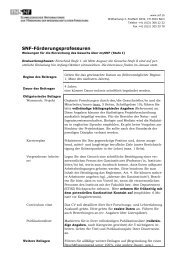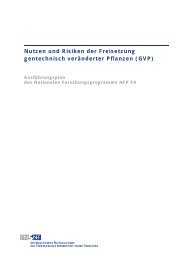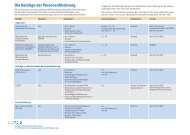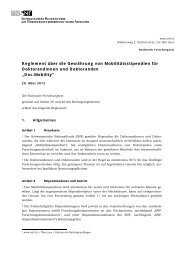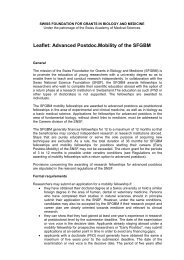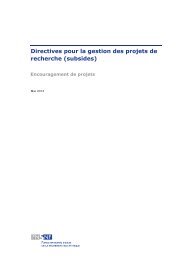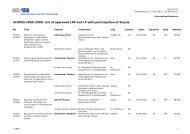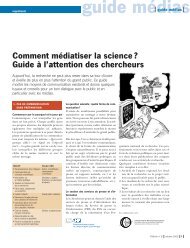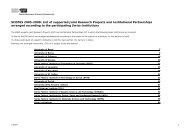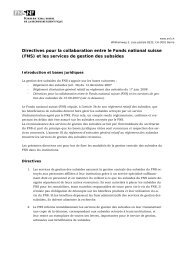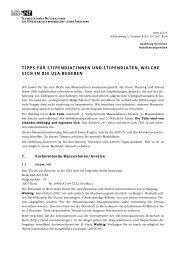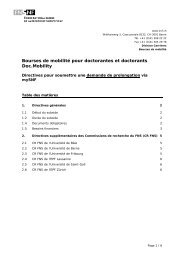NCCR Guide 2013 - Schweizerischer Nationalfonds (SNF)
NCCR Guide 2013 - Schweizerischer Nationalfonds (SNF)
NCCR Guide 2013 - Schweizerischer Nationalfonds (SNF)
Create successful ePaper yourself
Turn your PDF publications into a flip-book with our unique Google optimized e-Paper software.
Topics<br />
Historical Perspectives<br />
In its second phase the<br />
<strong>NCCR</strong> focuses on the historicity<br />
of media and mediality.<br />
It investigates forms<br />
of communication, transfer,<br />
and perception before the<br />
era of mass-media dominance<br />
and modern teleologically<br />
and technologically<br />
oriented media discourses,<br />
whose historical reach goes<br />
no further back than the introduction<br />
of film, radio, or<br />
television. The aim of the<br />
<strong>NCCR</strong> is a historical mediology<br />
which particularly<br />
examines change in communication<br />
practices, new<br />
dynamics in medial forms,<br />
and reflection on the conditions<br />
of communication.<br />
Special moments and constellations<br />
will be analysed,<br />
in which the medial can be<br />
grasped and described, as<br />
well as longer periods of<br />
change.<br />
The task of the historical<br />
mediology already in progress<br />
is to develop patterns<br />
Heads of Individual Research Projects<br />
Beil Ulrich J., PD<br />
Gamper Michael, Prof.<br />
Glaser Elvira, Prof.<br />
Glauser Jürg, Prof.<br />
Glessgen Martin-Dietrich, Prof.<br />
Hinrichsen Hans-Joachim, Prof.<br />
Kiening Christian, Prof.<br />
Kurmann-Schwarz Brigitte, Prof.<br />
Lutz Eckart Conrad, Prof.<br />
Müller-Nielaba Daniel, Prof.<br />
Naumann Barbara, Prof.<br />
Nievergelt Andreas, PD<br />
of description that allow<br />
us to understand how mediality<br />
has formed cultural<br />
meaning. The question is<br />
not so much what media<br />
are, but rather, what in<br />
which situations and processes<br />
works as a medium,<br />
and what are the specific<br />
conditions that make the<br />
medial possible. Emphasis<br />
is put therefore not only on<br />
the images that media present<br />
of the world, but also<br />
on those images of the medial<br />
that shape our notions<br />
of what media are. The historicity<br />
and imagination of<br />
the medial, as well as the<br />
particular historical dynamics<br />
and logics of mediality<br />
will be brought to light.<br />
Organised into a general<br />
overall field (A.) and four<br />
issue-related fields (B. Interference,<br />
C. Ostentation,<br />
D. Instrumentalisation and<br />
E. Transference), texts, images,<br />
maps, sculptures, architecture,<br />
textiles, sounds<br />
and films will serve to develop<br />
different but related<br />
perspectives on medial peculiarities<br />
of the premodern<br />
period. The period between<br />
the 12th and the 15th centuries<br />
forms the focus of research<br />
in the second phase<br />
of the <strong>NCCR</strong> as it did in<br />
the first. At the same time,<br />
however, the borders of European-Christian<br />
cultural<br />
traditions will be brought<br />
into focus, perspectives on<br />
the early modern period will<br />
be opened, and selected<br />
aspects of modernity will<br />
provide a basis to observe<br />
those phases of modernity<br />
in which in literature, art,<br />
and science media discourses<br />
begin to take shape<br />
- discourses which in turn<br />
formed the idea of a premodern<br />
mediality. Participating<br />
fields of the <strong>NCCR</strong><br />
are: German Literature and<br />
Linguistics, History, History<br />
of Art, Film Studies,<br />
Musicology, Scandinavian<br />
Studies, Romance Literature<br />
and Linguistics, and<br />
Law.<br />
Deutsches Seminar, Universität Zürich<br />
Deutsches Seminar, Universität Hannover<br />
Deutsches Seminar, Universität Zürich<br />
Deutsches Seminar, Universität Zürich<br />
Romanisches Seminar, Universität Zürich<br />
Musikwissenschaftliches Institut, Universität Zürich<br />
Deutsches Seminar, Universität Zürich<br />
Kunsthistorisches Seminar, Universität Zürich<br />
Departement für Germanistik, Université de Fribourg<br />
Deutsches Seminar, Universität Zürich<br />
Deutsches Seminar, Universität Zürich<br />
Deutsches Seminar, Universität Zürich<br />
Third Party Cooperation<br />
Research Institutions<br />
• Art History and Music, University<br />
of Birmingham, School of<br />
Languages, Cultures, GB<br />
• Biblioteca Mario Gromo, Museo del<br />
Cinema di Torino, IT<br />
• Capaciteitsgroep Duitse en<br />
Scandinavische talen en culturen,<br />
Universiteit van Amsterdam, NL<br />
• Centre André Chastel, Corpus<br />
Vitrearum France, FR<br />
• Cinémathèque Luxembourg,<br />
Filmarchiv, LU<br />
• College of Humanities, Arts<br />
and Social Sciences, History<br />
Department, US<br />
• Comparative Literature<br />
Department,Yale University,<br />
New Haven, US<br />
• CRH – GAHOM, Ecole des hautes<br />
études en sciences sociales EHESS,<br />
Paris, FR<br />
• Department of Art and Architecture,<br />
Harvard University, Cambridge, US<br />
• Department of English,<br />
Syddansk Universitet, Odense, NO<br />
• Department of Language and<br />
Culture, Linköping University, SE<br />
• Department of German,<br />
Princeton University, US<br />
• Department of Germanic Studies,<br />
New York University, US<br />
• Department of History, University<br />
of South Carolina, US<br />
• Department of Media,<br />
University of Copenhagen, DK<br />
• Department of Technology<br />
and Society Studies,<br />
University of Maastricht, NL<br />
• Deutsches Historisches Institut,<br />
Paris, FR<br />
• Deutsches Seminar, Leibniz<br />
Universität Hannover, DE<br />
• Deutsches Seminar I, Albert-<br />
Ludwigs-Universität Freiburg i.Br, DE<br />
• Dept. of Art and Architecture,<br />
Harvard University, Cambridge, US<br />
• Department of Film History and Aesthetics,<br />
Université de Lausanne, CH<br />
• Department of German,<br />
University of California, Berkeley, US<br />
• Department of Germanic Studies,<br />
University of Chicago, US<br />
• Department of History,<br />
Cornell University, US<br />
• Department of Literature, History<br />
of Ideas, and Religion,<br />
University of Gothenburg, SE<br />
• Dipartimento delle Arti Visive,<br />
Università di Bologna, IT<br />
• Dipartimento di letterature<br />
moderne e scienze dei linguaggi,<br />
Universität Siena, IT<br />
• Dipartimento di Storia delle Arti,<br />
della Musica e dello Spettacolo,<br />
Università degli studi di Milano, IT<br />
• Ecole des Hautes Etudes<br />
en Sciences Sociales, Paris, FR<br />
• Emmy-Noether-Research<br />
Group “History of Listening”,<br />
Max-Planck-Institut für Wissenschaftsgeschichte,<br />
Berlin, DE<br />
• English Department,Vanderbilt<br />
University, Nashville, Tennessee, US<br />
• Equipe d’accueil de Linguistique<br />
et Lexicographie Latine et<br />
Romane, Université de Paris, FR<br />
• EYE Nederlands Filmmuseum,<br />
Filmarchiv, NL<br />
• Fachbereich Geschichte und<br />
Soziologie, Universität Konstanz, DE<br />
• Fach Germanistik,<br />
Universität Duisburg-Essen, DE<br />
• Fakultät für Sprach- und<br />
Literaturwissenschaften, Griechische<br />
und lateinische Philologie,<br />
Universität München, DE<br />
• Filmmuseum Wien, Filmarchiv, AT<br />
• Forschungszentrum für<br />
mittelalterliche Glasmalerei,<br />
Corpus Vitrearum Deutschland, DE<br />
• Friedrich-Alexander-Universität<br />
Erlangen-Nürnberg, DE<br />
<strong>Guide</strong> <strong>2013</strong> | 89


